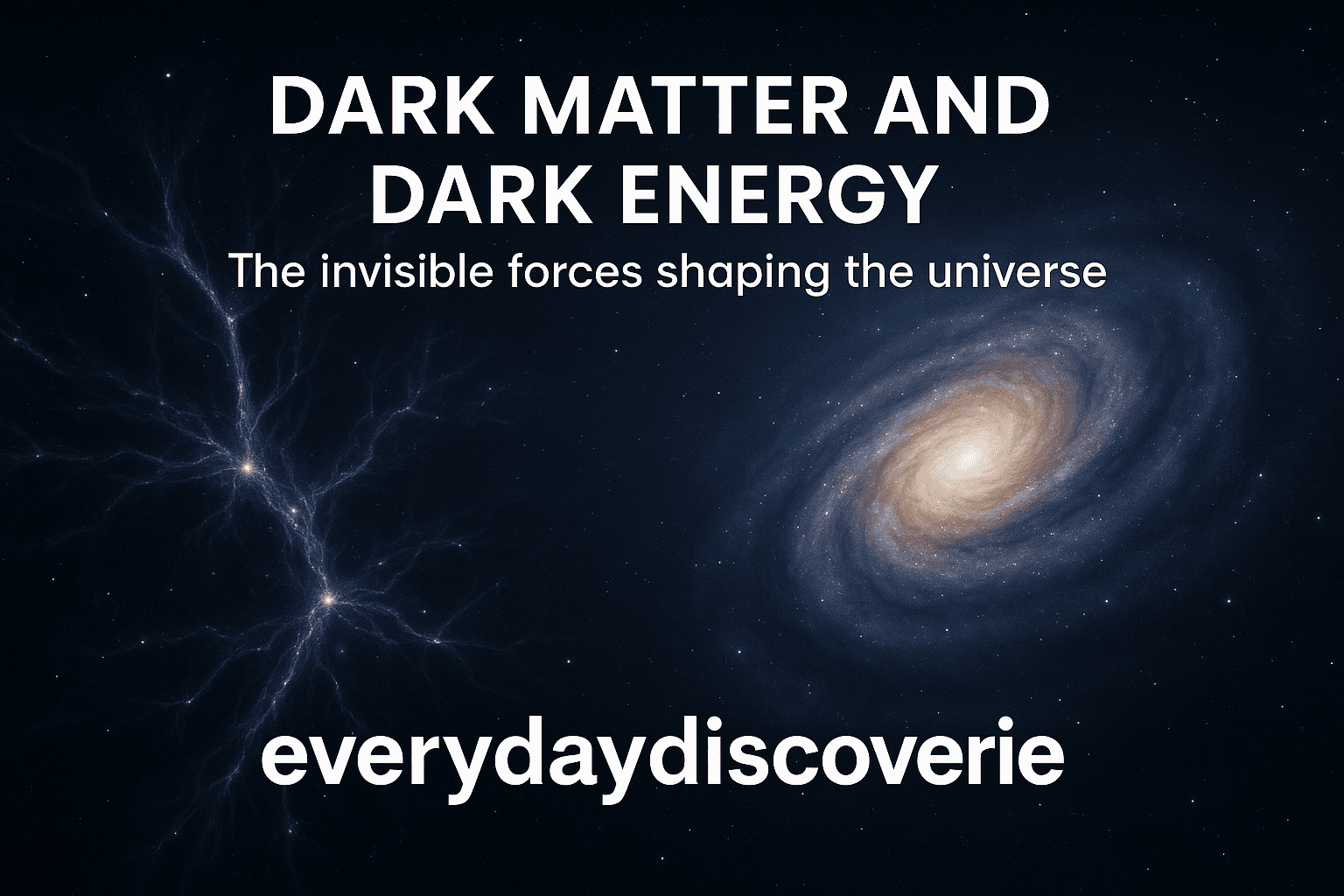Unseen Power: How Dark Matter and Dark Energy Control the Cosmos


Dark Matter and Dark Energy: The Invisible Forces Shaping the Universe
The universe is vast, mysterious, and filled with unknowns. While we have made incredible advancements in understanding celestial bodies, galaxies, and cosmic phenomena, there remain two enigmatic components that baffle scientists: dark matter and dark energy. These invisible forces shape the universe in ways we can barely comprehend, influencing everything from galaxy formation to the accelerating expansion of space. Despite their invisibility, they are estimated to make up about 95% of the total energy and mass in the cosmos. In this blog, we will explore what dark matter and dark energy are, their significance, how scientists study them, and the challenges they pose to our understanding of physics.
What is Dark Matter?
Dark matter is a mysterious, unseen substance that does not emit, absorb, or reflect light, making it completely invisible to telescopes. Yet, its presence is inferred due to its gravitational effects on visible matter, such as galaxies and stars. Scientists estimate that about 27% of the universe consists of dark matter, compared to only 5% of normal matter (which includes everything we can see and touch).
Evidence of Dark Matter
1. Galaxy Rotation Curves: When astronomers observed the rotation of galaxies, they noticed something strange. The outer edges of galaxies were moving just as fast as the inner regions, contradicting Newtonian physics, which suggests that objects farther from the center should move slower. This discrepancy suggests that an unseen mass (dark matter) provides additional gravity.
2. Gravitational Lensing: According to Einstein's theory of general relativity, massive objects bend light. When astronomers observe gravitational lensing, where the light from distant galaxies is bent by an invisible mass, it suggests the presence of dark matter.
3. Cosmic Microwave Background (CMB) Radiation: The afterglow of the Big Bang, known as the CMB, contains fluctuations that reveal information about the composition of the universe. These fluctuations match models that include dark matter, confirming its presence.
4. Galaxy Clustering: The way galaxies cluster together suggests that there is much more mass in the universe than what we can see, supporting the dark matter theory.
What is Dark Matter Made Of?
Despite knowing it exists, scientists are still unsure what dark matter is made of. Some leading candidates include:
- WIMPs (Weakly Interacting Massive Particles): Hypothetical particles that interact through gravity and the weak nuclear force but not electromagnetism, making them invisible.
- Axions: Extremely light particles that could form a kind of cosmic "sea" and explain dark matter.
- Sterile Neutrinos: A proposed type of neutrino that interacts only via gravity, making it a strong dark matter candidate.
Physicists are using underground detectors, particle accelerators, and astronomical observations to try and detect dark matter directly. However, as of now, it remains elusive.
What is Dark Energy?
If dark matter is responsible for holding galaxies together, dark energy is responsible for pushing them apart. Dark energy is the mysterious force that drives the accelerated expansion of the universe. It makes up about 68% of the universe, making it the dominant component of cosmic energy.
The Discovery of Dark Energy
In the late 1990s, astronomers studying distant supernovae expected to find that the universe's expansion was slowing down due to gravity. Instead, they found the opposite: the universe was expanding faster over time. This shocking discovery led to the realization that some unknown force—dark energy—was driving this acceleration.
Possible Explanations for Dark Energy
1. The Cosmological Constant (Λ) – Albert Einstein originally proposed the idea of a "cosmological constant" to counteract gravity and keep the universe static. After the discovery of cosmic expansion, this idea was revived as a possible explanation for dark energy. In this model, dark energy is simply a property of space itself, exerting constant pressure that pushes everything apart.
2. Quintessence – Some scientists propose that dark energy is not constant but rather a dynamic, evolving energy field that changes over time. This is referred to as quintessence, a hypothetical force that acts like a repulsive form of gravity.
3. Modified Gravity Theories – Some researchers suggest that our understanding of gravity might be incomplete. Instead of a mysterious energy, the acceleration of the universe’s expansion might be caused by a yet-to-be-discovered property of gravity on cosmic scales.
4. Vacuum Energy – Quantum mechanics suggests that even empty space is filled with tiny fluctuations of energy. Dark energy could be the large-scale effect of this "vacuum energy." However, theoretical predictions of this energy differ wildly from observed values, creating what is known as the "cosmological constant problem."
The Relationship Between Dark Matter and Dark Energy
While dark matter and dark energy seem like opposite forces—one pulling matter together and the other pushing it apart—they are both crucial in shaping the universe. In the early universe, dark matter played a key role in forming galaxies and large-scale structures. However, as the universe expanded, dark energy took over, accelerating the expansion and stretching these structures apart.
Could Dark Matter and Dark Energy Be Related?
Some theories suggest that dark matter and dark energy may be connected. One idea is that they could be two manifestations of a single unknown force or field that governs cosmic evolution. However, no strong evidence supports this yet.
How Scientists Study Dark Matter and Dark Energy
1. Large Hadron Collider (LHC): The LHC smashes particles together at high speeds, hoping to create or detect unknown particles that might be linked to dark matter.
2. Space Telescopes: Observatories like the Hubble Space Telescope and the James Webb Space Telescope analyze the effects of dark matter and dark energy on cosmic structures.
3. Direct Detection Experiments: Scientists have built underground laboratories, such as XENON1T and LUX-ZEPLIN, designed to detect interactions between dark matter particles and normal matter.
4. Supernova Observations: Astronomers study Type Ia supernovae to measure the expansion rate of the universe and understand dark energy’s role.
Challenges and Future Research
Despite decades of research, dark matter and dark energy remain two of the greatest mysteries in physics. Some challenges include:
- Lack of Direct Detection: While we have plenty of indirect evidence for dark matter and dark energy, we have yet to observe them directly.
- Contradictions in Theoretical Models: Many proposed explanations lead to inconsistencies with existing physics.
- The Nature of Gravity: If dark energy is actually a misunderstanding of gravity, we may need a new theory of physics to explain it.
Future missions, such as the Euclid Space Telescope and the Nancy Grace Roman Space Telescope, aim to uncover more about these mysterious forces. Scientists also hope that advancements in quantum physics and cosmology might provide new insights.
Dark matter and dark energy are the invisible architects of the universe, influencing its past, present, and future. While dark matter binds galaxies together, dark energy pushes them apart, driving cosmic expansion. Despite our growing understanding, they remain among the most profound unsolved mysteries in physics. As technology advances and new experiments are conducted, we may one day unlock the secrets of these cosmic enigmas, reshaping our understanding of the universe and its fundamental laws.
What do you think about dark matter and dark energy? Could they be part of an even bigger mystery? Let’s continue the conversation in the comments below!
